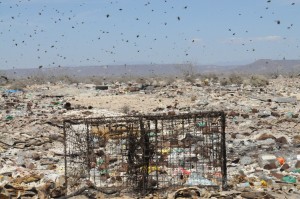
Our time in the lagoon began with Jesus Mayoral and his fiancée, Sabrina, who hosted us at Pachico’s Ecocamp. Jesus’ family was one of the first to settle in the lagoon years ago. I first met Jesus a year and a half ago when he approached Philanthropiece, told us of his vision for a clean lagoon and asked if we could assist him with this project. We have been working with Jesus and the community of Laguna San Ignacio since that time. Although this visit to the lagoon was to help facilitate a community waste disposal meeting with representatives from the various factions in the lagoon and surrounding areas, one of the highlights of the trip was our drive to outlying fishing villages to view how they dispose of their waste.
We began our adventure late in the afternoon, as Jesus, Sabrina, Leal, friends and I piled into two cars. Zooming along the salt flats was a welcome relief from the rutted, pothole-laden roads leading into and around the lagoon. Our first stop was El Delgadito, a fishing village at the end of a peninsula. Just before we reached the village, we crossed a raised dirt road that ran across the lagoon like a bridge. As I gazed out the window toward the water, the lagoon was white as snow. I was confused. For a moment, I was transported to the wind-blown, snow-covered mountain lakes of winter in my Colorado home, but it was 90 degrees here and we definitely were not in Colorado.
I asked Rita, “Is that salt?”
“Yes,” she said.
We had to stop and play!

Salt Angels
We all got out and ran towards the lagoon and the thick crust of salt crystals. Even Diente, Jesus’ dog, came along. We slid, jumped, laid down, made salt (snow) angels, and pried up chunks of salt to taste. Mmm – delicious sea salt! What a delight. Jesus told us that the village fisherman come here regularly to gather this salt to cure their fish.
We continued on, and as we approached El Delgadito, the roadside was strewn with mounds of garbage. Abandoned, rusted vehicles sat on the salt flats, a stone’s throw from the sea, leaching their contaminants into the lagoon. I was struck by the juxtaposition of the ugly trash and rotting cars silhouetted against the backdrop of the beautiful lagoon, as a heron stood motionless in the marsh, patiently fishing for its dinner.
We then drove to El Dátil and saw the same gorgeous, quiet, peaceful landscape, marred by garbage everywhere. The residents live amidst their trash. It damages the environment and health of their families. As we watched the sun set in this little village, I considered how communities like this exist all over the world and how we humans have created such a mess of our dear planet. We must find a healthier, more sustainable way to live. It strengthened my conviction to do what I can to make a difference.
The community waste disposal meeting was a success. The community members unified and were inspired to take responsibility for protecting their fragile ecosystem. They established the Laguna Limpia (Clean Lagoon) Committee and are implementing a viable waste disposal program. A new dumpsite was identified and the committee is seeking approval from the Ejido (land owners). The people in this Baja region rely on fishing and whale watching to survive. Perhaps it is the whale’s song that whispers to them, and calls for them to be good stewards of the land and sea.
Submitted By Lynn Thoré, Philanthropiece Advisory Board Member and Leal Lauderbaugh, Philanthropiece Technical Advisor

